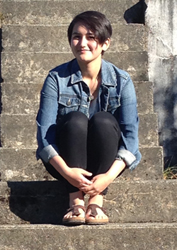The Veins of Nonfiction: L'Amour Lisik
in Conversation with J.D. Zapf

Malahat volunteer L'Amour Lisik talks with J.D. Zapf about “Median Love,” his nonfiction piece on the interconnectivity of modern love, set to be published in Issue #193.
Elusive Boundaries: Mapping CNF in Canada is the Malahat's first-ever nonfiction issue. See the Issue #193 page for web exclusives, online book reviews, and a complete list of contributors.
“Median Love” is built on research. What was the inspiration? Did you think of the piece before launching into your research or did you find inspiration while reading one of the many cited articles?
An assignment had me writing a piece on “Modern Love.” In the vein of The New York Times column of the same name, I was supposed to write about what I thought modern love was, or what modern love meant to me.
To write on how my parents’ relationship has shaped my idea of love, or to evaluate the love of my aunts, uncles, cousins, friends (or heaven forbid, my own love), was unappealing. And so, out of some tongue-in-cheek, I wondered if I could make people up to see what their modern love was about.
The citations, I think, were necessary to make the piece “nonfiction.” They helped, in turn, to make sure the characters were modern, as I used more recent stats, numbers, findings. And, interestingly, they made them feel a little more real because we so commonly make decisions based on consensus or review—why did we buy that or make that decision? Because when we looked it up that’s what the numbers and experts told us to do.
This piece can be seen as a hybrid of creative nonfiction and fiction. Many writers dispute the limits of CNF and whether or not it can be mixed with fiction. Are there any sacred boundaries you keep to when writing CNF?
I want to say yes. I think that creative nonfiction is based supremely in fact; it does not intentionally mislead the reader. But if we look at “Median Love,” I have made people up. So, is that not a form of lying?
I’d argue it isn’t, because my intent is clear. The story is intentionally set up like fiction—it is overly specific yet has no real setting and therefore could be about people anywhere, and there is an omniscient narrator.
There are other little things that identify to the reader that this is not a typical creative nonfiction piece. For example, no one has a last name, and the stats often steer us away from seriousness. So I would say I haven’t broken my golden rule of misleading the reader.
Though I am sure that others would disagree with me—that this is not CNF but fiction. And they are right too. Perhaps my use of stats to guide the story and the lives within it isn’t enough to make it factual.
I was fortunate enough to have this piece workshopped, but several of my peers thought it didn’t fit into CNF. And I understand that sentiment. Nonfiction affects us easier than fiction as it has us empathise differently. I think when we mislead we break the bond that makes nonfiction so powerful, in turn hurting the medium. Which is likely why A Million Little Pieces caused the outrage that it did and people were up in arms over James Frey’s book.
It wasn’t that the story wasn’t remarkable, or that the premise, ideas, and scenes weren’t based in fact. It was that it knowingly misled and people felt cheated for caring so deeply.
There’s an unexpected humour to this story. Did you intend to bring humour into your work, or did it manifest itself? How important is humour to your writing?
I think the humour, in part, stems from this piece having a mischievous foundation.
There was purposeful intention, though. Humour is such a wonderful way of engaging with readers and a challenge with the piece was finding ways to get readers to connect themselves with Mike and Jess.
Additionally, humour makes a story feel lighter, more nimble. And the piece’s premise works so much better if it’s read expeditiously. Moving through the story quickly, seeing the next moment in their life, and experiencing the ups and downs mixed with the realities implied by the stats; well, it has the effect of making characters more convincing and the ending more pronounced.
In regards to your second question, I’m not sure I use humour more than most, but it is something important to me because I’m very interested in telling stories in an off-the-cuff way. And I think that humour is such a valuable tool in storytelling. Humour is a utilitous thing that can relieve tension, entertain, or lighten the load of information-heavy pieces.
For me, your essay instilled a sad fear that my life would follow (or is already following) the same mediocre, statistic-worthy rhythm as the characters. Do you identify with this fear of a hollow existence? How do you deal with it?
Interesting how that happens, because I know what you mean. The characters actually have a pretty idyllic life with a partner who is intelligent and fair, with a relationship built on companionship. They have a daughter who confides worry, and goes to university. They have a dog. They travel the world and make it to a ripe, old age.
But maybe the story is too ideal. Or maybe because some of it speaks exactly to our life, or the lives of people we know, it feels preordained. And the notion that life-altering events are basically decided by a coin flip can make us wonder all sorts of what-ifs. For me that sense of sadness you’re talking about comes in a different way. The pace and length mean I get to the end and it feels like it came too soon.
How do I deal with the sense of a hollow existence that might end all too soon? Hmm. Well, I suppose that’s hidden somewhere in the story through the actions of the characters.
A different Joshua, Joshua Foer, explained it like this: “Monotony collapses time; novelty unfolds it.” Those unique moments in our life seem to be the longest and most detailed.
And I think that’s true, that daily routines make time move imperceptibly while new events stretch that sense of time out, making it seem longer and more defined. Often that means saying yes when you feel like saying no, involving yourself with others and allowing them to be involved in your life, and trying not to be so dang comfortable all the time.
Throughout your story, you’ve filled in some characterizing information that was lacking from the fact-generated characters. This sets them on the brink of being CNF or fiction characters because the details make them more human, more unique. Do these small offerings have roots in CNF, in your own life? Or were they written from a fiction point of view to round out the characters?
Yes to all of that. The general goal of this piece was to make those fact-generated people feel real. The stats actually do quite a good job of that; but, it is those small moments that truly bring them to life. I think perhaps because they seem private, like the characters are admitting some of their fondest memories. These moments are devoid of stats to emphasize the idea that they are individualized, personal.
In regards to them having roots in my own life, I’d like to say no. No because I don’t have a kid, or a house, or a wife. But, I suppose a flat out no would be a fib. For example, growing up, our Border Collie, Maggie, really did run around the house three times because she was so excited to see us. And things like that stick with you and stand out so vividly that when you share them on the page, it comes off in a sincere and colourful way.
But the rest of it falls to that old premise, “write what you know.” I don’t think either of my parents made a spoon into an airplane when they fed me formula; but I did think it felt right, maybe something I would lovingly do if I were to feed my child.
So, in regards to that, I’d like to say no, the details are not rooted in my life, but I drew on my life to make them feel more real. None of our dogs have ever worn a bandana but it felt like a nice memory the characters might share. Also, “a red bandana he wore begrudgingly” is a fun line—maybe even elicits a little snicker.
What other projects are you currently working on? What would you like to write about next?
These days I am mostly working on, well, work. Since much of that involves writing and editing I don’t often feel motivated to do those same things afterwards.
That said, when I do find myself sitting down to write or re-work a piece, I seem to be drawn towards fiction. In school I mostly pursued creative nonfiction and journalism. But I’m very curious to see if I could find success with that type of storytelling. It is a very satisfying medium to complete work in.

L'Amour Lisik
* * * * * * * *









